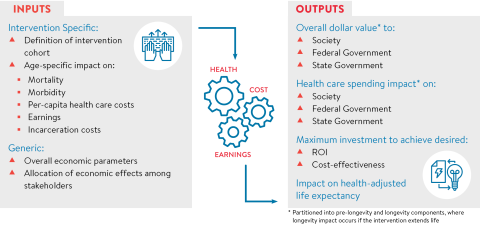
Measuring the Value of Health
Quantifying the Most Pressing Health Issues
The opioid crisis. Obesity. Smoking. Childhood lead exposure. These are some of the most serious public health issues facing our country today—and all come with significant economic and health costs to society. Communities affected by these issues need to create solutions, but it can be difficult to know where to start. In order to design effective policies and programs, they first need to understand the scope of the problem, identify areas of society most affected by it, and measure the expected impacts of targeted interventions. Altarum’s Value of Health tool (VOH) provides this information for counties, states, and nationally—forming a highly-customizable foundation to spur action at any scale.
Developed with funding from the Robert Wood Johnson Foundation (RWJF), the VOH measures the long-term impacts of investments in health—including those that address social determinants—on earnings, health, incarceration, and life expectancy. Further, it shows the investment’s accrued benefits and costs to people and organizations that can influence the investment.
How the Value of Health Tool Works

For each health issue, the VOH addresses the annual impact of an investment on the following:
- mortality, measured in life years;
- morbidity, measured in quality-adjusted life years (QALYs);
- health care spending by payer (Medicare, Medicaid/Children’s Health Insurance Program, private insurance, out of pocket);
- worker productivity, measured in earnings; incarceration costs (where relevant)
These annual impacts are input and converted to an overall dollar impact—and the portion of this impact that consists of health care spending—for the defined community. It also apportions these impacts among the stakeholders affected by the intervention. Measures of the value of the investment include increases in health-adjusted life expectancy (HALE) and the maximum investment that achieves a desired return on investment (ROI) or cost per QALY.
Results that are Relevant
Societal Impacts
From a societal perspective, interventions that improve health have multiple benefits, including increased longevity and more years of good health; greater productivity and longer labor force participation leading to higher gross domestic product (GDP); and lower health care costs until the longevity years—added years resulting from the investment—begin.
Of course, increased longevity brings additional societal impacts, including: additional health care costs; costs of food, shelter, and other essentials of living; and, if life is extended during the working years, higher GDP. The VOH captures all these effects. These results also are combined into measures of overall societal value, including cost per QALY, increased HALE, or—if a dollar value is placed on QALYs—ROI.
Federal and State Impacts
From a federal or state budget perspective, better health leads to lower health care spending during the pre-longevity period, which leads to lower Medicare and Medicaid costs. Better health also increases GDP, which leads to greater tax revenues and lower safety net spending. Greater longevity results in higher Medicare, Medicaid, and Social Security costs and, if life is extended during working years, greater tax revenues. The VOH captures all these effects.
Impacts of Inaction
The VOH also provides important data on the cost of not addressing a health issue. A recent application estimated the cost of opioid misuse, substance use disorders, and resultant premature mortality to exceed $500 billion between 2017 and 2020, if concerted and sustained action to address the crisis is not taken and current use and mortality rates persist.
Further, the VOH has the unique ability to apportion costs to demonstrate the full scope of the economic burden. In an analysis of the impacts of obesity for the state of Indiana, the VOH calculated that the majority of costs are borne by households and the private sector in the form of increased health care costs and lost future earnings; followed by the federal government; and finally, state and local governments, both driven by increased health care spending and lower income tax revenues.
Examples of Our Work
Applied Research and AnalyticsResults to Spur Action
Using the VOH, Altarum has developed a website that enables states to calculate the cost of childhood lead exposure and the economic benefit of interventions to reduce the risk of exposure, from replacing leaded drinking water service lines to eradicating lead paint hazards in older homes. Previous analysis by Altarum showed that communities who invest in interventions that reduce childhood lead exposure can reap a strong return on investment. Providing VOH lead prevention data at the state level equips public health leaders with the evidence-based foundation they need to take effective action and address pressing health issues in their communities.